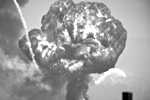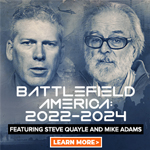
Official U.S. history of atomic bombing of Hiroshima and Nagasaki is more fiction than fact
Tuesday, February 28, 2006 by: Dani Veracity
Tags: atomic bomb, Hiroshima, Nagasaki
- European Court of Justice: Healthcare professionals who promoted or administered COVID-19 vaccines are CRIMINALLY LIABLE for any harm caused
- Newly released JFK files reveal Pentagon's role in creating Lyme disease and covid in the same lab
- Aerosolized bioweapons? Strange “diploid biomasses” falling out of the sky in Florida captured under the microscope
- Cinnamon plays a critical role in diabetes management
- Postcard from 1875 highlights smallpox vaccine’s failure: Lessons for today’s COVID-19 response
- When antibiotics are unavailable, natural ANTIMICROBIAL compounds become essential first line defenses against infection
- Oncologist warns of ‘terrifyingly aggressive’ cancers in children, linked to immune suppression from COVID vaccines
- German researchers find link between mRNA vaccines and GENETIC CHANGES that precede CANCER and AUTOIMMUNE DISORDERS
- Exclusive: Microscopic analysis suggests unknown biological contaminants falling from the sky
- AI-powered forecasting model proves more accurate than traditional systems at predicting the weather
- Scientists unveil breakthrough method to eliminate "Forever Chemicals" from water, transforming waste into graphene
- Nature's cold-fighting arsenal: Immune-boosting foods and healing recipes you need now
- DEATH by 12 VACCINES SIMULTANEOUSLY: Doctor playing catch-up on jabs injects 1-year-old baby with massive combination of dirty vax cocktails
- EPA reconsiders Obama's CO2 “Endangerment Finding” - could unleash American energy freedom
- Israeli forces execute Gaza medics, bury them in mass grave in Rafah
- Britain’s descent into police state censorship: Parents raided for questioning their daughter’s school system online
- “Bankrupt Tesla” movement EXPOSED: Left-wing extremists, Biden-linked operatives target Elon Musk in coordinated attack
- FBI imposed gag order on agents to silence Hunter Biden laptop truth before 2020 election, new chat logs reveal
- Newly released JFK files reveal Pentagon's role in creating Lyme disease and covid in the same lab
- Kiss Your Genetic Privacy Good-Bye! 23andMe Gets Green Light to Sell Your Intimate Genetic Details to Anyone They Want
- Oncologist warns of ‘terrifyingly aggressive’ cancers in children, linked to immune suppression from COVID vaccines
- Analysis: The coming economic collapse, a mass uprising and Trump's three secret weapons to halt the growing revolt
- European Court of Justice: Healthcare professionals who promoted or administered COVID-19 vaccines are CRIMINALLY LIABLE for any harm caused
- Dr. Suzanne Humphries makes bombshell appearance on Joe Rogan podcast, exposing vaccine industry deception back to POLIOMYELITIS
- Woman contracts WORLD'S DEADLIEST VIRUS after unknowingly being given the WRONG VACCINE
- NIH study, buried for decades, reveals that Flu Shots INCREASE elderly deaths, not prevent them
- Sugar-free deception: Artificial sweeteners hijack hunger signals, fuel obesity epidemic, study warns
- CDC finally halts $11 billion COVID funding scam as health officials admit the ‘pandemic’ was a fraud
- AI weather model outperforms traditional forecasts, boosts accuracy by 20%
- Black cumin seed oil emerges as a powerful ally against breast cancer and chronic inflammation
- Musk targets “strangely wealthy” lawmakers in DOGE probe, names Pelosi, McConnell, Schumer
- COVID-19 scandal linked to CANCER SURGE: Billionaire researcher sounds alarm
- “Independent” anti-Russia outlet MEDUZA faces COLLAPSE as US funding dries up
- The Health Ranger releases “Vaccine Zombie” song and music video, using AI-animated zombies for the music video
- DARPA: The shadowy innovator behind the world’s most advanced military technologies
- Britain’s descent into police state censorship: Parents raided for questioning their daughter’s school system online
- Newly released JFK files reveal Pentagon's role in creating Lyme disease and covid in the same lab
- California's social media censorship law struck down: A victory for free speech or a threat to online safety?
- EPA advisor admits the agency is funneling billions to climate groups ahead of Trump’s return to White House
- The Health Ranger releases “Vaccine Zombie” song and music video, using AI-animated zombies for the music video
- Dr. Mike Yeadon releases 15-minute testimony - WATCH - about genocidal intent of COVID “vaccines”
- Florida takes a stand: DeSantis proposes permanent ban on mRNA vaccine mandates
- Mike Adams releases country western hit single: Goin’ Back in Time is Comin’ Home
- Rep. Nancy Mace introduces bill to ban biological males from female facilities on federal property
- Unpacking the Lies That We’ve Been Fed – new song and music video released by Mike Adams, the Health Ranger
- “Why we influenced the 2020 elections”: Facebook files reveal the coordinated effort to bury the Hunter Biden laptop story
- House Intelligence Committee calls for the ARREST and PROSECUTION of Dr. Anthony Fauci
- Sugarcane extract superior to cholesterol-lowering drugs?
- The pandemic as a tool for INDOCTRINATION: Understanding “The Indoctrinated Brain” by Dr. Michael Nehls
- Survival 101: Effective EMF blocking techniques
- Mike Adams releases music poetry sensation: A Child of God
- Peter Rost exposes Big Pharma corruption in his book “The Whistleblower: Confessions of a Healthcare Hitman”
- Migrants are taking advantage of recent hurricanes to scam residents and loot their homes
- Michigan sheriff announces criminal investigation into 2020 election crimes, Dominion Voting Systems
- Red Cross issues warning to stop blood plasma donations from vaccinated people
- Scientists confirm: GENIUS brain function can be spontaneously unleashed in humans without any apparent cause
- EPA advisor admits the agency is funneling billions to climate groups ahead of Trump’s return to White House
- HYSSOP: What research reveals about the health benefits of this ancient holy herb
- Two containers with completed ballots fall out of truck in Florida
- Fully vaccinated about to see “tsunami” of illness and death, warns virologist
- Global leaders unite to clamp down on “misinformation” with UN-backed Cascais Declaration
- BREAKING: 2025 NDAA authorizes mandatory military draft of WOMEN across America… as Pentagon pursues global NUCLEAR war with both Russia and China at the same time
- Michael Yon warns of a ZIONIST TAKEOVER in Trump’s second administration
- Ozempic and Wegovy weight loss drugs are injectable LIZARD VENOM PEPTIDES that may unleash a devastating wave of organ failure… side effects align with symptoms of SNAKE BITES
- BOMBSHELL: DNA testing kits are a SCAM to develop ethnic-specific bioweapons
- Israeli soldiers accused of even more torture and abuse in the West Bank
- These 13 countries just signed an agreement to engineer a global FAMINE by destroying food supply
- NASA admits that climate change occurs because of changes in Earth’s solar orbit, and NOT because of SUVs and fossil fuels
- Newly released JFK files reveal Pentagon's role in creating Lyme disease and covid in the same lab
- RFK Jr. clears key hurdle: Sen. Susan Collins backs controversial HHS nominee, signaling a new era for health policy
- Sermon 30: How Jesus reveals Caesar’s FAKE CURRENCY and FALSE AUTHORITY
- Coriander seeds: Ancient medicine backed by modern science
However, what if much of what we've been told about Hiroshima and Nagasaki is a lie? How would our perceptions of World War II, of nuclear weapons, of the U.S. military and even of Japan change?
President Truman's first official announcement of the bombing of Hiroshima reflects all that we are supposed to believe about our nation's actions. Since the president was still at sea, his assistant press secretary Eben Ayers read the following statement to the Washington press corps: "Sixteen hours ago, an American airplane dropped one bomb on Hiroshima, an important Japanese Army base. That bomb had more power than 20,000 tons of TNT ... The Japanese began the war from the air at Pearl Harbor. They have been repaid many fold ... It is an atomic bomb. It is a harnessing of the basic power of the universe." Yes, the atomic bomb harnessed the "basic power of the universe" and yes, the bomb was more powerful than 20,000 tons of TNT; however, was the bombing a fair repayment for Pearl Harbor?
Based on the information that the government told the American people at the time, many Americans believed that it was fair. The U.S. government wasn't stupid; government officials knew exactly what to tell (and what not to tell) the public in order to keep popular opinion high. By classifying Hiroshima as an "important Japanese Army base," President Truman isolated the bombing as a military-to-military feat, as nothing more than an act of war. Additionally, as Greg Mitchell writes in his Editor and Publisher article "The Press and Hiroshima," the president stressed the size of the bomb (which was sure to impress most Americans), rather than the horrific effects of radiation, an aftereffect of an atomic bomb that most Americans were at the time probably ignorant of. Later on, in the days following Hiroshima, the Air Force provided American newspapers with an aerial photograph of the city and stressed that they had targeted an area with major industrial targets.
When a later U.S. survey of the damage to Hiroshima discovered that the bomb had mostly destroyed residential areas, the government did not release the information to the press. Any revealed information was part of a calculated public relations campaign that the contemporary press ate up with a spoon. As the military director of the Manhattan Project, Gen. Leslie Groves, later proudly remarked, "Most newspapers published our releases in their entirety. This is one of the few times since government releases have become common that this has been done." The press's almost exclusively positive coverage of the bombing then carried over to the American public, resulting in the misinformed perspective of the atomic bomb that has prevailed in the American consciousness for the past 60 years.
However, popular opinion of Hiroshima and Nagasaki may finally change now that previously censored information is becoming publicly available. On June 16, 2005 the Tokyo-based Mainichi Shimbun published four articles written by George Weller, the now-deceased Chicago Daily News reporter who was the first journalist to enter Nagasaki after the Aug. 9, 1945 atomic attack on the city. Weller was a true journalist, a nonconformist who wasn't afraid to put his neck on the line to get the truth. Rather than complying with Gen. Douglas MacArthur's press restrictions, Weller pretended to be a high-ranking military officer and managed to enter the city, where he toured the urban destruction, former POW camps and aid stations.
His arguably most important reports came from his hospital visits, where he observed and reported on the victims of "Disease X" (the effects of the radiation emitted from the atom bomb). Weller told of patients with "blackish" mouths and patches of red spots, children who were losing their hair and many apparently uninjured people who were mysteriously dying. "The doctors ... candidly confessed ... that the answer to the malady is beyond them ... They [the patients with Disease X] are dead -- dead of atomic bomb -- and nobody knows why."
Well, actually, the American scientists and government knew why, but they certainly weren't talking. Weller's reports would have undoubtedly made American public opinion of the bomb significantly less favorable. Gen. MacArthur and his censors in Tokyo knew this, which was why Weller's reports never saw the light of day until Weller's son, Anthony Weller, found his deceased father's carbon copies of the original reports. Now, 60 years later, we're finally able to see the obliterated Nagasaki through the Pulitzer Prize-winning journalist's eyes.
On the other hand, pictures really do tell a thousand words and actual footage of the atomic bombs' medical effects portrays unimaginable horrors inflicted upon the human life, which is precisely why the U.S. government kept the footage that was filmed in the two destroyed cities hidden from the American public until the 1980s. After the bombings, Japanese filmmakers attempted to document the horror that the atomic bombs left in Japan. Recognizing this as a potential threat, the U.S. military seized all Japanese footage and then placed an order banning all future filming. Gen. MacArthur then ordered Lt. Col. Daniel A. McGovern to direct a crew of 11 American filmmakers -- nine members of the U.S. military, including Herbert Sussan, and two civilians.
In Nagasaki, the crew made it a point to demonstrate the human effects of the bomb, including the shadows that the bodies of vaporized civilians left on the walls and the burned, scarred and poisoned radiation victims dying in the city's hospitals. Sussan later explained his reasoning to author and Hiroshima expert Greg Mitchell: "I felt that if we did not capture this horror on film, no one would ever really understand the dimensions of what had happened. At that time, people back home had not seen anything but black and white pictures of blasted buildings or a mushroom cloud." Unfortunately, oddly beautiful images of mushroom clouds remained the American public's only perspective of Nagasaki and Hiroshima for too long, as the Department of Defense and the Atomic Energy Commission kept Lt. Col. McGovern and Sussan's 80 reels of film buried away in the National Archives, its benign label of "#342 USAF" speaking nothing of the horrors captured on the film within the canisters.
Both the seized Japanese footage and the U.S military footage remained hidden from public view for decades. In the late 1960s, the Japanese government negotiated with the U.S. State Department, asking for the seized black-and-white film to be returned to Japan. The United States shipped a copy of the newsreel to Japan, which evoked the curiosity of filmmaker Erik Barnouw. After seeing the footage for himself at the National Archives in Maryland, Barnouw decided to edit the 160-minute material down to 16 minutes of marginal, yet powerful footage, placing images of the bombs' human effects near the end of the film for maximum impact. Barnouw's "Hiroshima-Nagasaki 1945" was screened at New York's Museum of Modern Art, but none of the three main television networks would air the film.
Oddly enough, NBC doubted that the film would have a "news hook." The U.S. military had declassified the McGovern/Sussan footage in the mid-1970s, but the film remained obscure until a chance meeting between Sussan and Tokyo antinuclear activist Tsutomu Iwakura prompted the latter to explore the issue. After finding the film reels in the National Archives, Iwakura and 200,000 Japanese donators amassed half a million dollars and bought the film from the National Archives. The horrific footage first appeared on the American screen in a film called "Dark Circle," which was an enormous success at the 1982 New York Film Festival, yet received no press coverage whatsoever.
The 50th anniversary of the bombings in 1995 increased press coverage of the McGovern/Sussan footage; however, American popular opinion of our military actions remained unchanged. As "Dark Circle" co-director Chris Beaver told Mitchell, "It's no wonder the government didn't want us to see it. I think they didn't want Americans to see themselves in that picture. It's one thing to know about that and another to see it." Yet so far, not even seeing it can make the American public believe that our nation acted wrongly.
It's now 2006. Last Fall, on Aug. 6 and 7, 2005, the film "Original Child Bomb" debuted on the Sundance cable channel. It was the first film to use not only the footage that Lt. Col. McGovern and Sussan shot for the military, but also Lt. Col. McGovern's home movies of the disastrous aftereffects. Has the broadcasting of that movie changed the American popular perspective of the atomic bomb? Will it ever change? Lt. Col. McGovern told Mitchell -- who was an advisor for the film -- that he believes many of the people who were responsible for the bombings are sorry about what happened: "I always had the sense that people in the Atomic Energy Commission were sorry we had dropped the bomb. The Air Force -- it was sorry. I was told by people in the Pentagon that they didn't want those images out because they showed effects on man, woman and child. They didn't want the general public to know what their weapons had done ... We didn't want the material out because ... we were sorry for our sins." Isn't it time for all of us as a nation to be sorry about what we did to two cities full of civilians?
Hiroshima and Nagasaki fact and fiction:
- Lie: Leaflets were dropped on Japanese cities to warn civilians to evacuate.
- Truth: Leaflets were dropped after we bombed Hiroshima and Nagasaki.
- Lie: Our use of the atomic bombs shortened the war.
- Truth: The Japanese were looking for peace when they returned from the Potsdam Conference on Aug. 3, 1945, three days before the U.S. military bombed Hiroshima.
- Lie: We bombed Hiroshima, which was an important Japanese Army base.
- Truth: We bombed the city center of Hiroshima, which had a population of 350,000.
- Truth: Only four of the 30 targets were, in fact, military in nature.
- Lie: The destroyed area of Hiroshima contained major industrial targets.
- Truth: The only "industrial" targets were three textile mills.
- Truth: Residential areas sustained the most damage.
- Truth: Less than 10 percent of Hiroshima's manufacturing, transportation and storage facilities were damaged.
- Lie: Residual radiation was not a threat to the American soldiers who stayed to occupy Hiroshima and Nagasaki.
- Truth: The "black rain" that fell after the bombings contaminated the ground, which was one of the many sources of residual radiation.
Works Cited
Bird, Kai and Sherwin, Martin J. "The Myths of Hiroshima." Los Angeles Times. 5 Aug 2005. http://www.commondreams.org
Mitchell, Greg. "A Great Nuclear-Age Mystery Solved." Editor and Publisher. 16 Jun 2005.
"Hiroshima Film Cover-Up Exposed." Editor and Publisher. 6 Aug 2005. http://www.editorandpublisher.com
"The Press and Hiroshima: August 6, 1945." Editor and Publisher. 5 Aug 2005. http://www.editorandpublisher.com
Radiation Effects Research Foundation. "Residual Radiation." 2003. http://www.rerf.or.jp
Atomic bomb at FETCH.news
Get independent news alerts on natural cures, food lab tests, cannabis medicine, science, robotics, drones, privacy and more.
Take Action: Support Natural News by linking to this article from your website
Permalink to this article:
Embed article link: (copy HTML code below):
Reprinting this article:
Non-commercial use OK, cite NaturalNews.com with clickable link.
Follow Natural News on Facebook, Twitter, Google Plus, and Pinterest
Science News & Studies
Medicine News and Information
Food News & Studies
Health News & Studies
Herbs News & Information
Pollution News & Studies
Cancer News & Studies
Climate News & Studies
Survival News & Information
Gear News & Information
News covering technology, stocks, hackers, and more



"Big Tech and mainstream media are constantly trying to silence the independent voices that dare to bring you the truth about toxic food ingredients, dangerous medications and the failed, fraudulent science of the profit-driven medical establishment.
Email is one of the best ways to make sure you stay informed, without the censorship of the tech giants (Google, Apple, Facebook, Twitter, YouTube, etc.). Stay informed and you'll even likely learn information that may help save your own life."
–The Health Ranger, Mike Adams













































